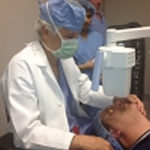
For those of you who have not heard of keratoconus, it is a corneal disease that causes structural changes within the cornea causing the cornea to thin and bulge outward into a steeper, irregular, more conical shape than its normal gradual curve. Keratoconus can cause substantial visual loss of vision, image distortion, streaking of lights, sensitivity to light, and multiple images, etc. Keratoconus affects about one person in a thousand, and yet the exact cause of it is uncertain.
Dr. Slade has been involved with finding a safe treatment for keratoconus from its discovery and this has been an ongoing effort for several years. He has been involved in clinical trials, written papers and provided presentations about the disorder, recommendations, potential treatments and results, all over the United States and around the world.
He has been interviewed in this article for Ocular Surgery News where he makes a very powerful and true statement regarding the need for the FDA to approve treatment. At the end of the day, the goal is to fight blindness. Please read below for Dr. Slade’s perspective and click on the link at the bottom of this page to read the full article:
During an open public hearing, several speakers referred to reports of adverse events resulting from LASIK and questioned the incidence of keratoconus. Others, including Stephen G. Slade, MD, OSN Refractive Surgery Board Member, voiced strong support for cross-linking.
Slade, representing the American-European Congress of Ophthalmic Surgery, pointed out that the literature overwhelmingly supports cross-linking as a safe and effective treatment for progressive keratoconus and corneal ectasia.
“Our society urges the panel to consider strongly the recommendation to FDA to approve this technique,” Slade said. “Cross-linking, as discussed today, this technique works. There are papers now with 10-year follow-up.”
Slade called cross-linking a “patient-friendly technique” that halts the progression of keratoconus in a vast majority of cases. “This is the pure science. This is fighting blindness,” Slade said. “Nothing could make me happier than to have a technique such as cross-linking where I can say that I have done my last graft on a keratoconus patient.”
To read more about keratoconus, cross-linking and the treatments we can provide at our office, please visit our Crosslinking page or call our office at





